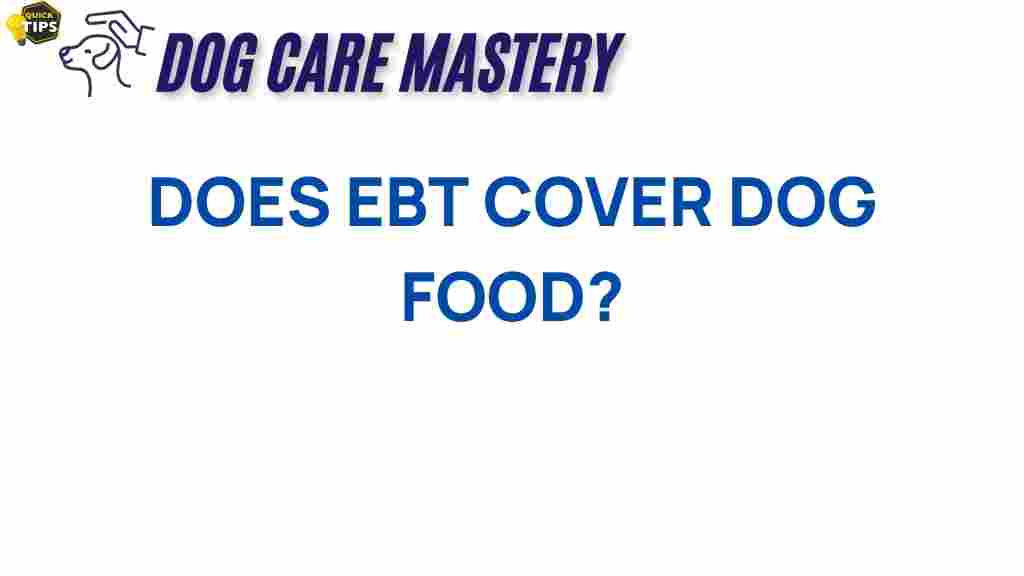Unraveling the Mystery: Does EBT Cover Dog Food?
For many pet owners, the well-being of their furry companions is as important as their own. However, when it comes to budgeting and managing expenses, especially in challenging financial times, one question often arises: Does EBT cover dog food? Understanding the ins and outs of the Electronic Benefits Transfer (EBT) program can help clarify this issue, making it easier for pet owners to navigate their options.
What is EBT?
EBT, or Electronic Benefits Transfer, is a system used in the United States to distribute government benefits, primarily through the Supplemental Nutrition Assistance Program (SNAP). This program helps low-income individuals and families afford food, ensuring they have access to necessary nutrition. While EBT is essential for many, it is crucial to understand what it covers and what it does not.
Does EBT Cover Dog Food?
The short answer to whether EBT covers dog food is no—EBT benefits do not extend to pet food. EBT is specifically designed for human food purchases, focusing on items that contribute to a balanced diet for individuals and families. Here’s a closer look at why dog food is excluded from EBT eligibility:
- Program Restrictions: EBT benefits are intended for human consumption only. Federal guidelines explicitly limit the use of these benefits to food products that are meant for people.
- Pet Care Products: While pet food is essential for the health and well-being of pets, it does not fall under the category of necessary human nutrition.
- Alternative Assistance: There are various other programs and resources available for pet food assistance, which can help pet owners in need.
Understanding the Limitations of EBT
To further comprehend why EBT does not cover dog food, it’s essential to be aware of the program’s limitations:
- Eligible Items: EBT can be used to purchase items that are typically found in grocery stores, including fruits, vegetables, dairy products, meat, and bread.
- Ineligible Items: Alcohol, tobacco products, vitamins, medicines, and pet foods are all excluded from EBT purchases.
Alternative Solutions for Pet Food Assistance
If you are a pet owner relying on EBT and facing difficulties in providing for your dog, there are alternative avenues you can explore for assistance:
1. Local Food Banks
Many food banks offer pet food alongside their regular food assistance programs. Here’s how you can find help:
- Search online for local food banks in your area.
- Contact them to inquire about pet food assistance.
- Some food banks may have specific days dedicated to distributing pet food.
2. Pet Food Pantries
Similar to food banks, pet food pantries specifically cater to the needs of pets. These organizations provide free or low-cost pet food to families in need.
- Look for pet food pantries in your local community.
- Check with local animal shelters, as they often have connections to pet food assistance programs.
3. Community Resources and Nonprofits
Several nonprofit organizations focus on providing food and other resources for pets in need:
- Organizations such as Pet Food Pantry offer support for pet owners struggling to afford food for their animals.
- Reach out to local animal shelters; they may have resources or can guide you to available programs.
4. Veterinary Clinics and Animal Hospitals
Some veterinary clinics and animal hospitals may have programs or partnerships that provide assistance with pet food:
- Inquire at your local vet about any available resources for pet food assistance.
- Ask if they can recommend local organizations that can help.
Step-by-Step Process to Secure Pet Food Assistance
To help you navigate securing assistance for your pet’s food needs, follow these steps:
Step 1: Assess Your Needs
Determine how much assistance you need and how often you require help with pet food. Knowing your needs will help you communicate effectively with organizations.
Step 2: Research Local Resources
Use online searches or community boards to find local food banks, pet food pantries, and nonprofit organizations that offer pet food assistance.
Step 3: Reach Out for Help
Contact the organizations you’ve found and inquire about their pet food assistance programs. Be prepared to provide information about your situation if necessary.
Step 4: Visit and Apply
If applicable, visit the organizations to fill out any necessary applications or forms. Bring identification and any required documentation.
Step 5: Stay Informed
Stay updated on any changes to these programs and their availability. Some organizations may have specific eligibility requirements, so it’s good to keep in touch.
Troubleshooting Tips for Pet Food Assistance
When seeking assistance, you may encounter challenges. Here are some troubleshooting tips:
1. Be Persistent
If one organization cannot help, don’t hesitate to reach out to others. There are many resources available, and persistence can pay off.
2. Network with Other Pet Owners
Connect with other pet owners in your community. They may have insights into resources you haven’t discovered yet.
3. Stay Organized
Keep track of the organizations you’ve contacted, their requirements, and any follow-up actions needed. This will make the process smoother.
4. Seek Community Support
Consider joining local social media groups or forums dedicated to pet ownership. These platforms can provide valuable information and support.
Conclusion
In summary, EBT does not cover dog food, as its focus is on human nutrition. However, pet owners looking for assistance have numerous alternatives to explore. From local food banks and pet food pantries to nonprofit organizations and veterinary clinics, resources are available to help you care for your furry friends. By being proactive and resourceful, you can ensure your pet receives the nourishment they need, even during challenging times.
For more information on how to navigate pet food assistance, feel free to check out additional resources such as this comprehensive guide.
This article is in the category Safety and created by dogcaremastery Team
